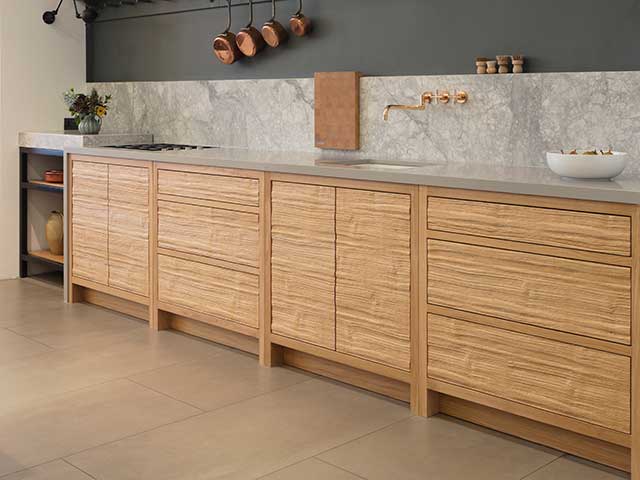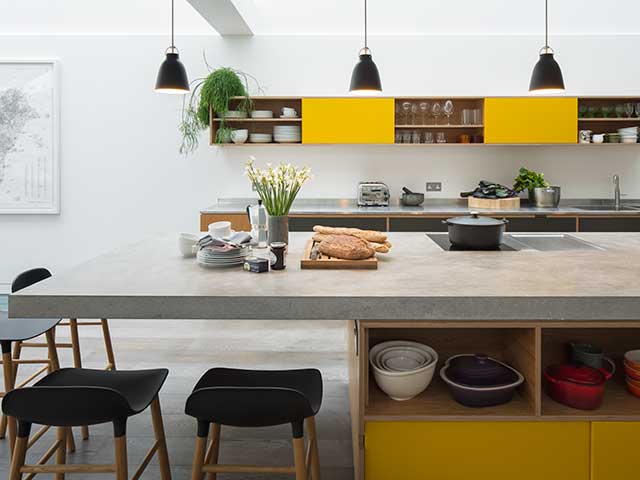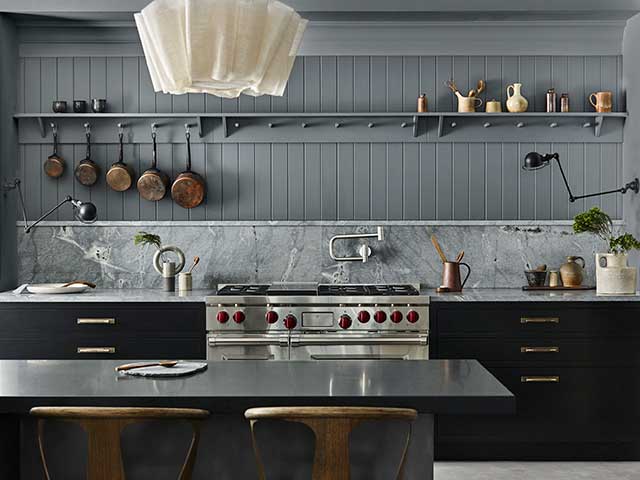20 kitchen worktop ideas
From eco options to hi-tech wonders, find the right worksurface solution for your project
There are three main factors to consider when choosing your kitchen worktops. Can the practical benefits of a surface’s material suit your needs? Will it look great as part of the project? Will the design you like fit within your budget? Keep reading for expert advice and plenty of kitchen worktop ideas from the top retailers.
1. Reuse and revamp
Scour salvage yards for stone, marble or timber that can be made into characterful kitchen worktops. Look out for school laboratory workbenches, which are often made from quality hardwood, as well as reclaimed floorboards and cost-effective scaffolding planks. Extension project with bespoke kitchen painted in Black Blue from Farrow & Ball, and island worksurface made from reclaimed parquet flooring, sealed with raw oil. Design and project management by All & Nxthing.

Photo: All & Nxthing
2. Slim or chunky?
Surface depth is a factor to consider – options range from super-shallow 4mm to a standard 20-30mm up to more than 50mm, depending on the type of material. Malton kitchen in Seal Grey with Cosentino Eternal Calacatta Gold quartz worksurface, available in thicknesses of 20mm or 30mm, from Kitchen Makers.

Photo: Kitchen Makers
3. Chips off the old block
Resin-based terrazzo is durable and can include recycled waste stone or glass chippings. The random pattern of the embedded material makes each piece unique. TE081 resin terrazzo worksurface from Diespieker & Co.

Photo: Diespieker & Co
4. Go for a greener option
Eco-friendly solid surface and quartz composites include the carbon-offset Sunlit Day quartz range from Silestone, and Durat, which is made with recycled post-industrial plastic waste. Durat worksurface with integrated Block II sinks from Surface Matter.

Photo: Surface Matter
5. Practically perfect
Sintered stone, also known as porcelain, is made from natural minerals bonded together under extreme heat and pressure. Durable and resistant to stains and chipping, it can be used to clad cabinets, walls and floors, or to wrap around an island. Calacatta Light Ceramic SapienStone worksurface from Cullifords.

Photo: Cullifords
6. Pick a finish
The appearance of a natural stone will be affected by the finish. Polished is bright and glossy, honed is more matt, and brushed is smooth, matt, and looks slightly paler than a polished treatment. Antique Anorthosite stone kitchen worktops from Lundhs.

Photo: Lundhs
7. Industrial quality
There are several benefits to choosing a metal-topped surface. Steel is easy to clean and heat resistant. Copper is antimicrobial and eco-friendly, while bronze and brass are low maintenance and create a distinctive design feature. Forge reclaimed timber kitchen with concrete and bronze worksurfaces. The bronze surface has an aged copper patina. From Bert & May.

Photo: Bert & May
8. Create an upstand feature
Try coordinating two different materials for impact. This speckled grey quartz composite kitchen worktops is contrasted with a boldly veined stone upstand that highlights the linear layout. Urbo oak river-washed kitchen with Silestone Kensho polished quartz composite worksurface (cosentino.com) and quartzite White Fantasy splashback from Roundhouse.

Photo: Roundhouse
9. Design flexibility
Versatile solid surface composites from brands such as Hi-Macs and Corian come in a vast number of colours, as well as the latest stone and concrete effects. They are precision-fitted for a join-free finish. Lava Rock worksurface and integrated Sparkling sink with stainless steel base from Corian.

Photo: Corian
10. Going all out
Extending a worksurface to create a breakfast bar or tabletop will require additional support if the overhang is more than 300mm. Choose brackets or glazing for hidden reinforcement. Interior design, Boffi Burnished Gold kitchen, ceramic worksurfaces and glazed support from Retrouvius.

Photo: Francesca’s Paints
11. Hi-tech tricks
Some designs incorporate LED lighting and integrated wireless charging ports. TPB Tech has invisible induction cooktops, while Eggersmann and Boffi offer retractable surfaces. Zerox handleless kitchen and worksurface in Fenix Matt Black with smart-ready integrated strip lighting from Rotpunkt.

Photo: Rotopunkt
12. Robust and refined
A concrete surface cast in situ will be tailored to each kitchen, with an infinite number of designs possible. Professional installation ensures a durable and long-lasting finish. Applying a sealant prevents water absorption and staining. Bespoke oak-veneered plywood kitchen cabinetry from Uncommon Projects. Cantilevered concrete island worksurface from White+Reid.

Photo: White+Reid
13. Rock solid
All stone requires sealing to protect it from water damage and staining, but granite, travertine and slate are more impervious than marble or limestone. The slabs can be very heavy, so ensure that the cabinets are strong enough to bear the weight. Contemporary Classic matt lacquer kitchen painted in Pitch Black Matt and Down Pipe from Farrow & Ball with Atlantic Stone granite and Nero Assoluto honed granite worksurfaces from Roundhouse.

Photo: Roundhouse
14. Natural opulence
Book- or slip-matched marble is where two or more slabs are carefully joined so that the pattern of veining looks continuous. It’s an expensive option, requiring regular sealing and cleaning, but for a luxury look it’s hard to beat. Bespoke timber kitchen in Little Greene’s Basalt with Calacatta marble worksurfaces and island from Blakes London.

Photo: Blakes London
15. Spend or save?
Most bespoke kitchen companies take care of everything, from designing and sourcing materials to measuring up and fitting. A less expensive route is to buy online or direct from suppliers, but don’t forget the cost of installation. Turtle Green quartzite from Cullifords.

Photo: Cullifords
16. Mixed materials
Blend natural elements with industrial stylings for a contemporary look. Smile Kitchens offers a number of worktop options, from solid wood to ceramic, quartz and blended acrylic. Combine with cupboards from their new Löfte range, which is available in 10 distinct textures – choose from natural wood grains, a metallic finish or marble.

Photo: Smile Kitchens
17. Layer it up
For clean lines in a minimalist kitchen, try a floating breakfast bar. This project by Kitchen Architecture combines a Bulthaup b3 kitchen island in kaolin with a cantilevered breakfast bar in stained oak, eliminating the need for legs or supports.

Timber-clad rear extension by McNulty Architects. Photo: Darren Chung
18. Fully bespoke
When looking for truly unique kitchen worktop ideas, it pays to go bespoke. This project by Blakes London, part of an extension, refurbishment and interior design by The Vawdrey House, features an island worktop made of textured, leathered marble with rounded, timber-wrapped edges.

Photo: Blakes London
19. Go vertical
Make your kitchen island work even harder by extending your work surface upwards. Not only does this create a room divide for open-plan spaces, it also offers invaluable extra storage. This custom element was created by Husk, which offers an affordable way to add bespoke elements to your kitchen.

Photo: Husk
20. Keep it trim
For a slim, sleek profile, choose a compact laminate kitchen worktop like this one from Smile Kitchens. These high-performance surfaces are an affordable alternative to real composite surfaces. Made from several sturdy layers, they are waterproof, resistant to a high level of heat, and durable against abrasion and impact. They come in a range of colours from worn copper to white marble.

Photo: Smile Kitchens
Fitting a kitchen worktop
Advice on installation from Oli Moss, senior designer at Roundhouse:
- When fitting any kitchen worktops it is vital to ensure that the base units are level and securely fixed so there will be no movement once it’s in place. This will help reduce any stress on surface materials and will prevent potential bowing.
- Bespoke stone, quartz composite, porcelain, metal and solid surface installations will require templating so they can be precisely and professionally cut or fabricated off site. You will need to allow one to two weeks prior to fitting by a specialist installer, but a temporary surface can be fitted so the kitchen is usable in the meantime.
- Although it is possible to buy ready-to-fit pre-cast concrete versions, most seamless concrete and terrazzo worksurfaces are cast on site by a specialist installer. Allow time for measuring up, making the mould and pouring the concrete, plus extra for hardening and curing, a process that can take at least 30 days.
- Most laminate and timber worksurfaces can be cut to fit on site as soon as the base units are in place, saving time and money. I recommend professional installation for the best results, but surfaces can be fitted by anyone who’s competent in DIY.
- When calculating costs, take into consideration layout as well as material choices. Straight surface runs will inevitably be more cost-effective as they are easier to fit. Expect to pay an additional fee for each extra joint, for hob or sink cut-outs, and for drainer grooves.









